2001 BMW 330Ci COUPE ignition
[x] Cancel search: ignitionPage 10 of 203

Contents
Overview
Controls and features
Cockpit16
Instrument cluster18
Indicator and warning lamps20
Multifunction steering wheel
(MFL)24
Hazard warning flashers25
Warning triangle25
First-aid kit25
Refueling26
Fuel specifications27
Tire inflation pressure28
Opening and closing:
Keys32
Electronic vehicle
immobilizer33
Central locking system34
Opening and closing Ð from the
outside34
Opening and closing Ð from the
inside38
Luggage compartment lid39
Luggage compartment41
Alarm system42
Electric power windows44
Sliding/Tilt sunroof45
Adjusting:
Seats47
Seat and mirror memory51
Steering wheel52
Mirrors52
Car Memory, Key Memory54
Passenger safety systems:
Safety belts55
Airbags57
Transporting children safely60
Driving:
Steering/Ignition lock63
Starting the engine63
Switching off the engine64
Parking brake65
Manual transmission66
Automatic transmission with
Steptronic67
Turn signal indicator/Headlamp
flasher70
Washer/Wiper system70
Rear window defroster72
Cruise control73
Everything under control:
Odometer75
Tachometer75
Energy Control75
Fuel gauge76
Temperature gauge76
Service Interval Display76
Check Control77
Computer77
Technology for driving comfort
and safety:
Park Distance Control (PDC)81
Automatic Stability Control plus
Traction (ASC+T)82
Dynamic Stability Control
(DSC)83
Tire Pressure Control (RDC)85
Contents
Page 25 of 203
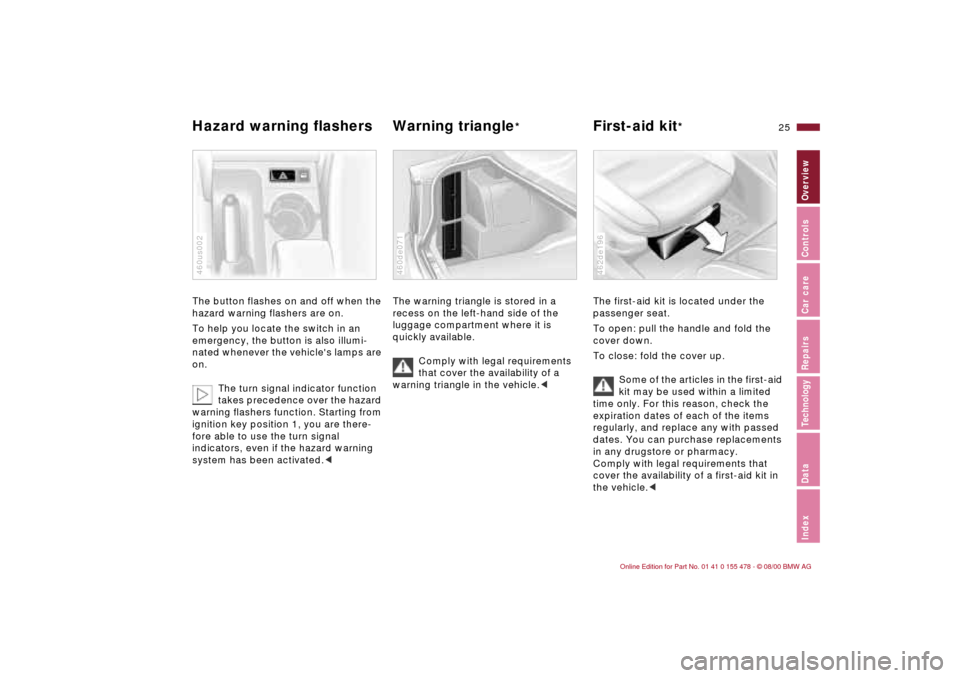
25n
IndexDataTechnologyRepairsCar careControlsOverview
Hazard warning flashers Warning triangle
*
First-aid kit
*
The button flashes on and off when the
hazard warning flashers are on.
To help you locate the switch in an
emergency, the button is also illumi-
nated whenever the vehicle's lamps are
on.
The turn signal indicator function
takes precedence over the hazard
warning flashers function. Starting from
ignition key position 1, you are there-
fore able to use the turn signal
indicators, even if the hazard warning
system has been activated.< 460us002
The warning triangle is stored in a
recess on the left-hand side of the
luggage compartment where it is
quickly available.
Comply with legal requirements
that cover the availability of a
warning triangle in the vehicle.<460de071
The first-aid kit is located under the
passenger seat.
To open: pull the handle and fold the
cover down.
To close: fold the cover up.
Some of the articles in the first-aid
kit may be used within a limited
time only. For this reason, check the
expiration dates of each of the items
regularly, and replace any with passed
dates. You can purchase replacements
in any drugstore or pharmacy.
Comply with legal requirements that
cover the availability of a first-aid kit in
the vehicle.< 462de196
Page 31 of 203

Overview
Controls and features
Operation, care
and maintenance
Owner service procedures
Technical data
Index Advanced technology
31n
IndexDataTechnologyRepairsCar careControlsOverview
Driving:
Steering/Ignition lock63
Starting the engine63
Switching off the engine64
Parking brake65
Manual transmission66
Automatic transmission with
Steptronic67
Turn signal indicator/Headlamp
flasher70
Washer/Wiper system70
Rear window defroster72
Cruise control73
Everything under control:
Odometer75
Tachometer75
Energy Control75
Fuel gauge76
Temperature gauge76
Service Interval Display76
Check Control77
Computer77
Technology for driving comfort
and safety:
Park Distance Control (PDC)81
Automatic Stability Control plus
Traction (ASC+T)82
Dynamic Stability Control (DSC)
with Automatic Differential
Brake (ADB) and Dynamic
Brake Control (DBC)83
Tire Pressure Control (RDC)85Lamps:
Side lamps/Low beams87
Instrument panel lighting87
High beams/Parking lamps88
Fog lamps88
Interior lamps88
Controlling the climate
for pleasant driving:
Air conditioner90
Automatic climate control96
Seat heating101
Roller sun blind101
Interior convenience:
HiFi System101
Glove compartment102
Storage facilities102
Cellular phone104
Ashtray, front104
Cigarette lighter105
Ashtray, rear105
Clothes hooks105
Loading and transporting:
Through-loading system106
Ski bag107
Cargo loading108
Roof-mounted luggage rack109
Page 32 of 203
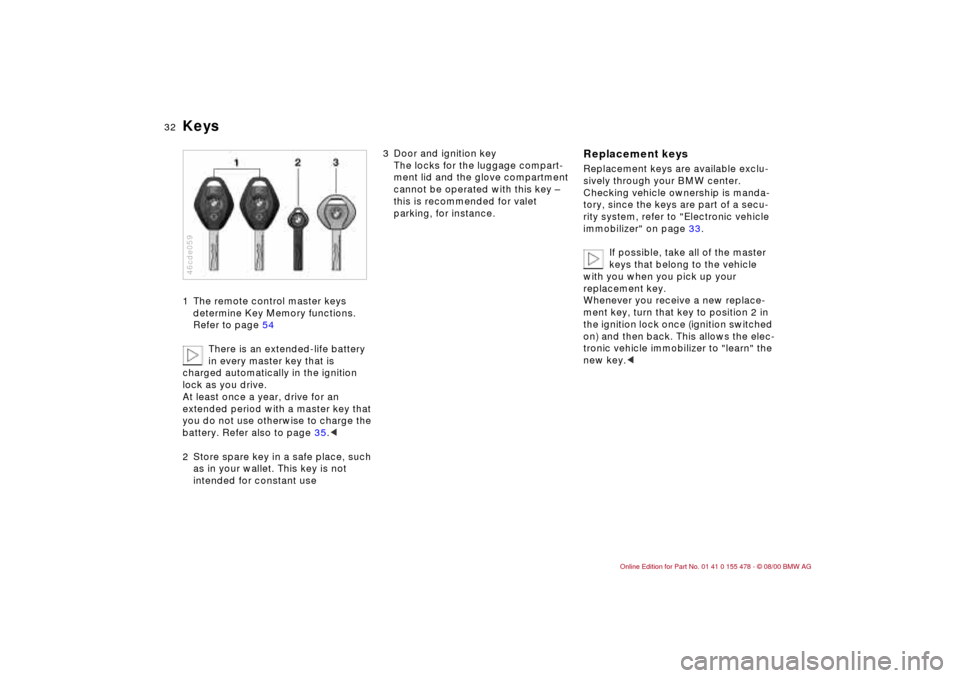
32n
Keys1 The remote control master keys
determine Key Memory functions.
Refer to page 54
There is an extended-life battery
in every master key that is
charged automatically in the ignition
lock as you drive.
At least once a year, drive for an
extended period with a master key that
you do not use otherwise to charge the
battery. Refer also to page 35.<
2 Store spare key in a safe place, such
as in your wallet. This key is not
intended for constant use 46cde059
3 Door and ignition key
The locks for the luggage compart-
ment lid and the glove compartment
cannot be operated with this key Ð
this is recommended for valet
parking, for instance.
Replacement keysReplacement keys are available exclu-
sively through your BMW center.
Checking vehicle ownership is manda-
tory, since the keys are part of a secu-
rity system, refer to "Electronic vehicle
immobilizer" on page 33.
If possible, take all of the master
keys that belong to the vehicle
with you when you pick up your
replacement key.
Whenever you receive a new replace-
ment key, turn that key to position 2 in
the ignition lock once (ignition switched
on) and then back. This allows the elec-
tronic vehicle immobilizer to "learn" the
new key.<
Page 33 of 203
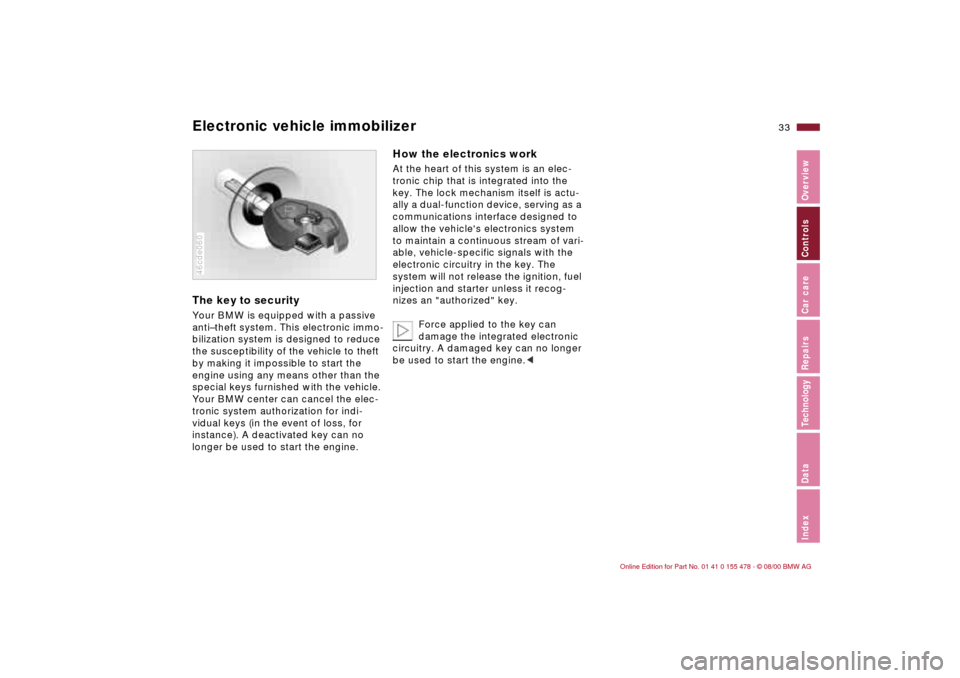
33n
IndexDataTechnologyRepairsCar careControlsOverview
Electronic vehicle immobilizer The key to securityYour BMW is equipped with a passive
antiÐtheft system. This electronic immo-
bilization system is designed to reduce
the susceptibility of the vehicle to theft
by making it impossible to start the
engine using any means other than the
special keys furnished with the vehicle.
Your BMW center can cancel the elec-
tronic system authorization for indi-
vidual keys (in the event of loss, for
instance). A deactivated key can no
longer be used to start the engine.46cde060
How the electronics workAt the heart of this system is an elec-
tronic chip that is integrated into the
key. The lock mechanism itself is actu-
ally a dual-function device, serving as a
communications interface designed to
allow the vehicle's electronics system
to maintain a continuous stream of vari-
able, vehicle-specific signals with the
electronic circuitry in the key. The
system will not release the ignition, fuel
injection and starter unless it recog-
nizes an "authorized" key.
Force applied to the key can
damage the integrated electronic
circuitry. A damaged key can no longer
be used to start the engine.<
Page 35 of 203

35n
IndexDataTechnologyRepairsCar careControlsOverview
Opening and closing Ð from the outsideUsing the remote control The remote control gives you an
exceptionally convenient method for
unlocking and locking your vehicle.
Furthermore, it provides two additional
functions that can only be executed by
means of the remote control:
>Turn on the interior light, refer to
page 36.
With this function, you can also
"search for" your vehicle Ñ when
parked in an underground garage for
instance.
>Open the luggage compartment,
refer to page 37.
The luggage compartment lid will
open slightly, regardless of whether it
was locked or unlocked.
The anti-theft system is also deacti-
vated simultaneously when you unlock
the vehicle, the alarm system is
disarmed, and the interior lamps are
turned on. When you lock the vehicle,
the systems are activated and armed,
and the lamps go off.
You can have a signal set as an
acknowledgment message that
the vehicle is closed correctly.<
Master keysKeys with remote control are master
keys. Refer to page 32.
Children might be able to lock the
doors from the inside. For this
reason, always take the vehicle keys
with you so that the vehicle can be
opened again from the outside at any
time.<462de280
Master keys that are used repeat-
edly are always ready for opera-
tion since the battery in the key is
charged automatically in the ignition
lock as you drive.
If it is no longer possible to unlock the
vehicle using the remote control, the
battery is discharged. Use this key
while driving for an extended period in
order to recharge the battery. Refer
also to page 32.
To prevent unauthorized use of the
remote control, surrender only the door
and ignition key or the spare key (refer
to page 32) e. g. when leaving the
vehicle for valet parking.
In the event of a system malfunction,
please contact your BMW center. You
can also obtain replacement keys
there.<
Page 39 of 203
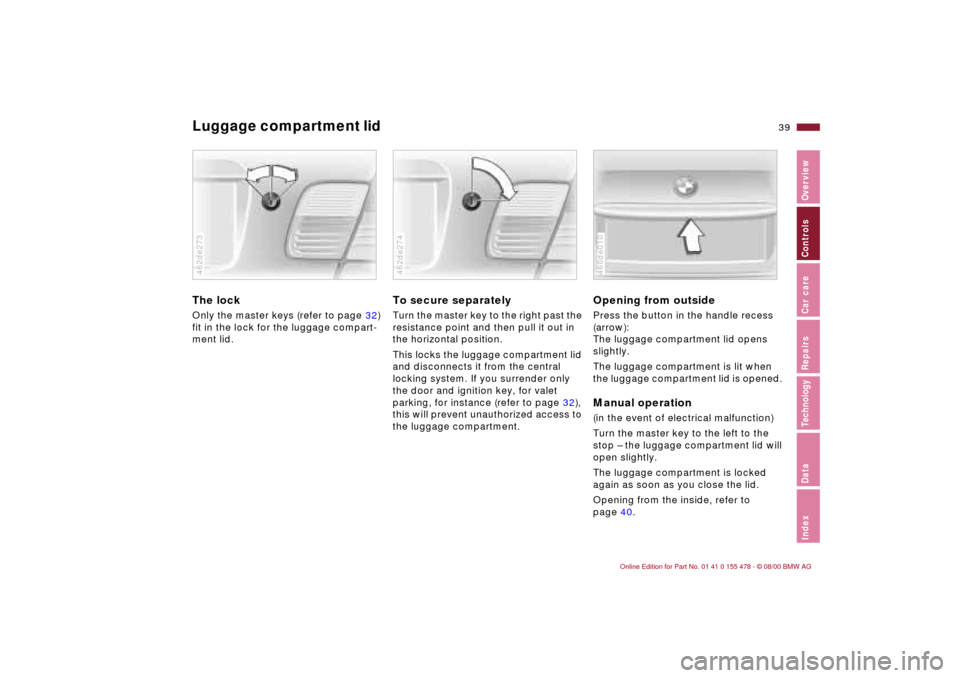
39n
IndexDataTechnologyRepairsCar careControlsOverview
Luggage compartment lid The lock Only the master keys (refer to page 32)
fit in the lock for the luggage compart-
ment lid.462de273
To secure separatelyTurn the master key to the right past the
resistance point and then pull it out in
the horizontal position.
This locks the luggage compartment lid
and disconnects it from the central
locking system. If you surrender only
the door and ignition key, for valet
parking, for instance (refer to page 32),
this will prevent unauthorized access to
the luggage compartment.46cde001462de274
Opening from outsidePress the button in the handle recess
(arrow):
The luggage compartment lid opens
slightly.
The luggage compartment is lit when
the luggage compartment lid is opened. Manual operation(in the event of electrical malfunction)
Turn the master key to the left to the
stop Ð the luggage compartment lid will
open slightly.
The luggage compartment is locked
again as soon as you close the lid.
Opening from the inside, refer to
page 40.06cde010460de010
Page 44 of 203
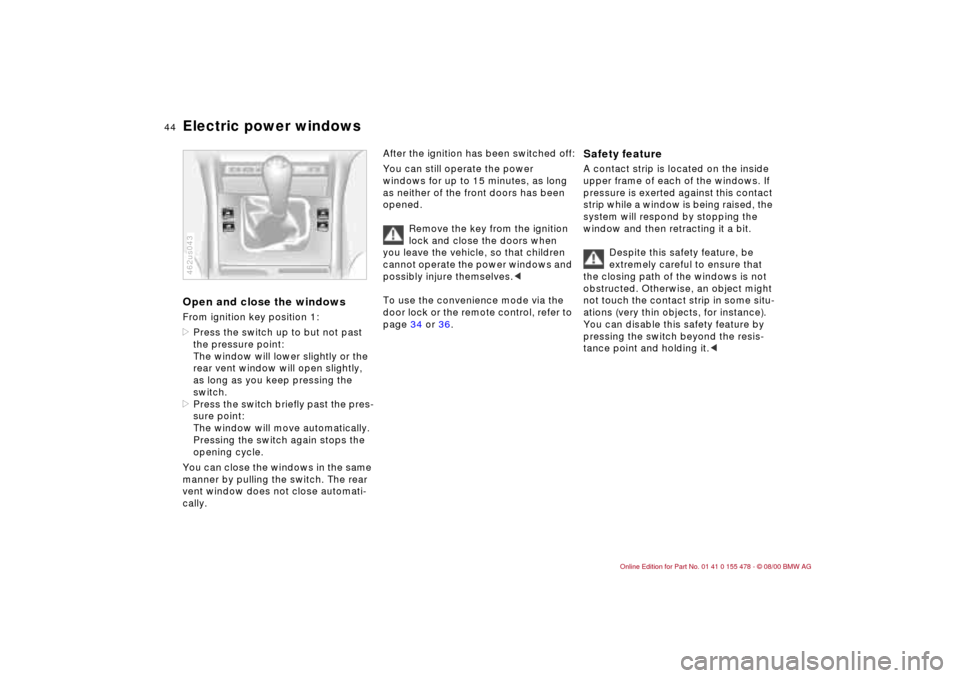
44n
Electric power windowsOpen and close the windowsFrom ignition key position 1:
>Press the switch up to but not past
the pressure point:
The window will lower slightly or the
rear vent window will open slightly,
as long as you keep pressing the
switch.
>Press the switch briefly past the pres-
sure point:
The window will move automatically.
Pressing the switch again stops the
opening cycle.
You can close the windows in the same
manner by pulling the switch. The rear
vent window does not close automati-
cally.462us043
After the ignition has been switched off:
You can still operate the power
windows for up to 15 minutes, as long
as neither of the front doors has been
opened.
Remove the key from the ignition
lock and close the doors when
you leave the vehicle, so that children
cannot operate the power windows and
possibly injure themselves.<
To use the convenience mode via the
door lock or the remote control, refer to
page 34 or 36.
Safety feature A contact strip is located on the inside
upper frame of each of the windows. If
pressure is exerted against this contact
strip while a window is being raised, the
system will respond by stopping the
window and then retracting it a bit.
Despite this safety feature, be
extremely careful to ensure that
the closing path of the windows is not
obstructed. Otherwise, an object might
not touch the contact strip in some situ-
ations (very thin objects, for instance).
You can disable this safety feature by
pressing the switch beyond the resis-
tance point and holding it.<